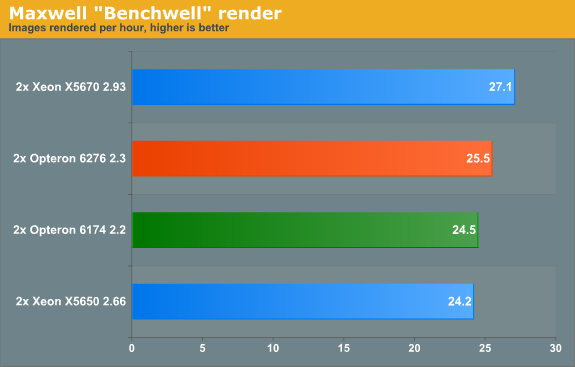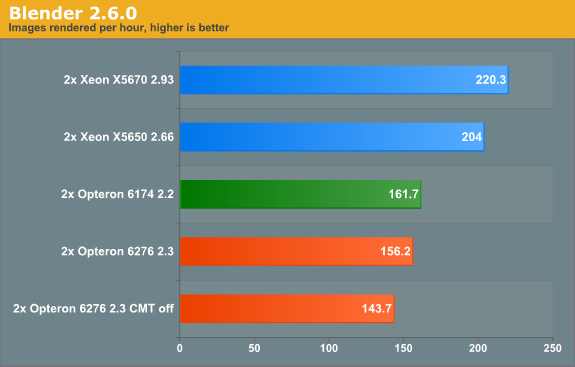Bulldozer for Servers: Testing AMD's "Interlagos" Opteron 6200 Series
by Johan De Gelas on November 15, 2011 5:09 PM ESTMaxwell Render Suite
The developers of Maxwell Render Suite--Next Limit--aim at delivering a renderer that is physically correct and capable of simulating light exactly as it behaves in the real world. As a result their software has developed a reputation of being powerful but slow. And "powerful but slow" always attracts our interest as such software can be quite interesting benchmarks for the latest CPU platforms. Maxwell Render 2.6 was released less than two weeks ago, on November 2, and that's what we used.
We used the "Benchwell" benchmark, a scene with HDRI (high dynamic range imaging) developed by the user community. Note that we used the "30 day trial" version of Maxwell. We converted the time reported to render the scene in images rendered per hour to make it easier to interprete the numbers.

Since Magny-cours made its entrance, AMD did rather well in the rendering benchmarks and Maxwell is no difference. The Bulldozer based Opteron 6276 gives decent but hardly stunning performance: about 4% faster than the predecessor. Interestingly, the Maxwell renderer is not limited by SSE (Floating Point) performance. When we disable CMT, the AMD Opteron 6276 delivered only 17 frames per second. In other words the extra integer cluster delivers 44% higher performance. There is a good chance that the fact that you disable the second load/store unit by disabling CMT is the reason for the higher performance that the second integer cluster delivers.
Rendering: Blender 2.6.0
Blender is a very popular open source renderer with a large community. We tested with the 64-bit Windows version 2.6.0a. If you like, you can perform this benchmark very easily too. We used the metallic robot, a scene with rather complex lighting (reflections) and raytracing. To make the benchmark more repetitive, we changed the following parameters:
- The resolution was set to 2560x1600
- Antialias was set to 16
- We disabled compositing in post processing
- Tiles were set to 8x8 (X=8, Y=8)
- Threads was set to auto (one thread per CPU is set).
To make the results easier to read, we again converted the reported render time into images rendered per hour, so higher is better.

Last time we checked (Blender 2.5a2) in Windows, the Xeon X5670 was capable of 136 images per hour, while the Opteron 6174 did 113. So the Xeon was about 20% faster. Now the gap widens: the Xeon is now 36% faster. The interesting thing that we discovered is that the Opteron is quite a bit faster when benchmarked in linux. We will follow up with some Linux numbers in the next article. The Opteron 6276 is in this benchmark 4% slower than its older brother, again likely due in part to the newness of its architecture.











106 Comments
View All Comments
geoxx - Friday, December 9, 2011 - link
Sorry but neotiger is totally right, choice of benchmark sucks. We are not helped *at all* by your review.What company 32-core server is being used for 3D rendering, cinebench, file compression, truecrypt encryption??
You benchmarked it like it was a CPU of the nineties for a home enthusiast.
You are probably right pointing us to http://www.anandtech.com/show/2694 but your benchmarks don't reflect that AT ALL. Where are file compression, encryption, 3D rendering and cinebench in that chart?
Even performances per watt is not very meaningful because when one purchases a 2-socket or 4-socket server, electricity cost is not an issue. Companies want to simplify deployment with such a system, they want this computer to run as fast as a cluster, in order not to be bound to cluster databases which are a PAIN. So people want to see scalability of applications to full core count on this kind of system, not so much performances per watt.
Virtualization is the ONLY senseful benchmark you included.
TPC as suggested is a totally right benchmark, that's the backend and bottleneck for most of the things you see in your charts at http://www.anandtech.com/show/2694 , and objection on storage is nonsense, just fit a database in ramdisk (don't tell me you need a database larger than 64GB for a benchmark), export as block device, then run the test. And/or use one PCI-e based SSD which you certainly have.
http://www.anandtech.com/show/2694 mentions software development: how much effort does it require to set up a linux kernel compile benchmark?
http://www.anandtech.com/show/2694 mentions HPC: can you set up a couple of bioinformatics benchmarks such as BLAST (integer computation, memory compare), GROMACS (matrix FPU computations) and Fluent? Please note that none of your tests includes memory compares and FPU which are VERY IMPORTANT in HPC. Gromacs and fluent would cover the hole. Bioinformatics is THE hpc of nowdays and there are very few websites, if any, which help with the choice of CPUs for HPC computing.
For email servers (37%!) and web servers (14%) also I am sure you can find some benchmarks.
Iketh - Tuesday, November 15, 2011 - link
I'm not sure how the discovery of cores running in their power-saving state for far too long is anything new. My 2600k refuses to ramp up clocks while previewing video in a video editor even though a core is pegged at 100%. If I intervene and force it to 3.4ghz, preview framerate jumps from 8 fps to 16fps.This has been happening for YEARS! My old quad Phenom 2.2ghz did the exact same thing!
It's extremely annoying and pisses me off I can't benefit from the power savings, let alone turbo.
MrSpadge - Tuesday, November 15, 2011 - link
Sounds like you're running linux or some other strange OS, then. Or you may need a bios update. Generally Intel has its power management quit under control. In the AMD camp physical power state switches often take longer than the impatient OS expects, and thus average frequency is hurt. This was pretty bad for Phenom 1.MrS
Iketh - Tuesday, November 15, 2011 - link
win7 home premium x64 and the phenom was with xp 32bit... i haven't found another scenario that causes this, only streaming video that's rendered on-the-flyZoomer - Wednesday, November 16, 2011 - link
You have a 2600k and aren't running it at 4+ GHz?Iketh - Wednesday, November 16, 2011 - link
4.16 @ 1.32v when encoding, 3.02 @ 1.03v for gaming/internethaplo602 - Wednesday, November 16, 2011 - link
you do know that Linux did not have any problems with Phenom I power management unlike Windows ? Same is not with BD. Linux benchmarks look quite different from Windows and the gap is not that dramatic there.BrianTho2010 - Tuesday, November 15, 2011 - link
This whole review, the only thought I have is that there are no sandy bridge chips in it. When SB based Xeon chips come out I bet that Interlagos will be completely dominated.Beenthere - Tuesday, November 15, 2011 - link
Not really. SB chips don't fit in AMD sockets. AMD's installed customer base like the significant performance increase and power savings by just plugging in a new Opteron 6200/4200.C300fans - Tuesday, November 15, 2011 - link
It will. 2x6174 (24 cores) perform quite similar to 2x6274(32 cores). WTF